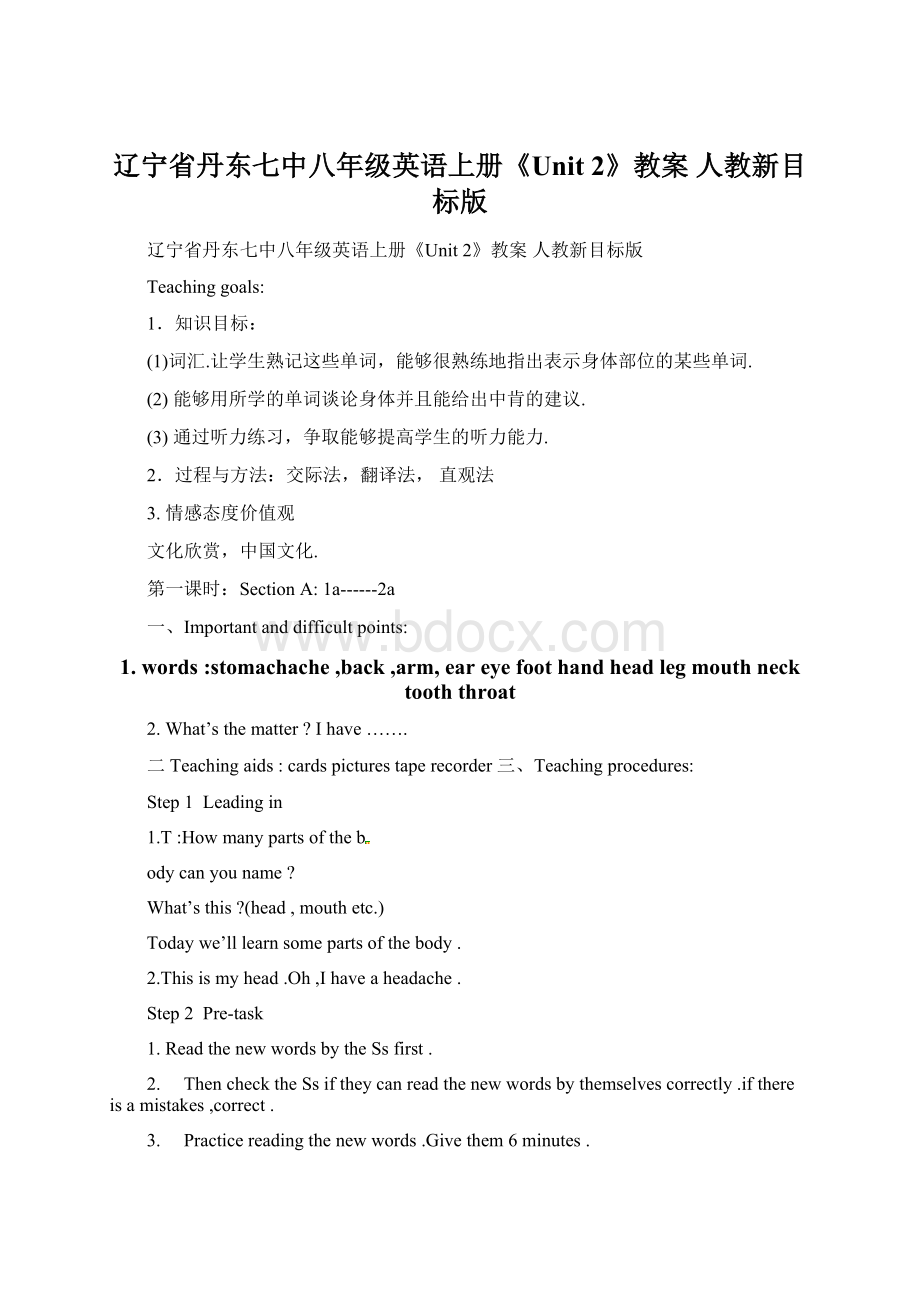 辽宁省丹东七中八年级英语上册《Unit 2》教案 人教新目标版Word格式.docx
辽宁省丹东七中八年级英语上册《Unit 2》教案 人教新目标版Word格式.docx
- 文档编号:21228830
- 上传时间:2023-01-28
- 格式:DOCX
- 页数:15
- 大小:24.67KB
辽宁省丹东七中八年级英语上册《Unit 2》教案 人教新目标版Word格式.docx
《辽宁省丹东七中八年级英语上册《Unit 2》教案 人教新目标版Word格式.docx》由会员分享,可在线阅读,更多相关《辽宁省丹东七中八年级英语上册《Unit 2》教案 人教新目标版Word格式.docx(15页珍藏版)》请在冰豆网上搜索。

(head,mouthetc.)
Todaywe’lllearnsomepartsofthebody.
2.Thisismyhead.Oh,Ihaveaheadache.
Step2
Pre-task
1.ReadthenewwordsbytheSsfirst.
2.
ThenchecktheSsiftheycanreadthenewwordsbythemselvescorrectly.ifthereisamistakes,correct.
3.
Practicereadingthenewwords.Givethem6minutes.
4.
Haveacompetitionbetweenboysandgirls.Writethewordsyourememberedjustnowontheblackboard.
5.
Page7,1a.DothispartbytheSsfirst.Writethecorrectletterafterthenameofeachbodypartonthelist.
6.
Checktheanswers.
7.
Playagame.AlltheSscloseyourbooks,we’llhaveainstructortosay:
Touchyournose/head/rightear….Let’sseewhichstudentdoitcorrectlyandquickly.FirstalltheSsdothisgame.Thenhavecompetitionsbetweenboysandgirls.5boysand5girlstothefronttodowhattheinstructorsaid.ifyouarewrong,pleasegobacktoyourseats,thelastonewhostandsatthefrontisthewinner.
Step3
While-task
SBPage7,1b.Listenandchecktheanswers.
SBPage7,1c.Workinpairsandactout.
SBPage8,2a.
1.
Pointouttheeightitemsinthisactivity.Readtheitemtotheclass.Ssrepeat.
Therearedifferentconversations.Listencarefully.peoplearetalkingabouthealthproblemstheyhaveandgettingadvice.
Matchtheproblemswiththeadvice.
Playthetapetwice.
Step4
Post-task
同桌之间设计一个医生与病人之间的对话.
四、板书设计
1.What’sthematter?
Ihaveacold.
2.asorethroat,seeadentistliedownandrest,hotteawithhoney
五、Homework
A;
Rememberthenameofyourbodypart.
B;
MakesomeconversationsWriteC;
writeconversationsbetweenthedoctorandthepatient.
第二课时:
SectionA:
2b__-3b
(一)Importantanddifficultpoints:
Youshoulddo…….Youshouldn’tdo……..
(二)Teachingaids:
somepictures,taperecorder
(三)Teachingprocedures:
Freetalk.
Reviseplayingthegame.
Practicereadingthedialogues.
SBPage8,2b.
Payattentiontothefourpictures.Eachofthesepicturesillustratesoneoftheconversations.
Playthetape,writethemissingwordsontheblanklines.
Playthetapeagainandchecktheanswers.
Pairwork.Practicereadingthedialoguesinthepictures.Taketurnshavingtheproblemandgivingtheadvice.
Practicereadingthedialoguein2c,andmaketheironwconversations.
5.Actoutthedialogue.
SBPage9,3a.
PointoutthepictureandaskSstodescribeit.(Thereisaboysittingonabench.He’ssick.Ateacheristalkingtohim)
Payattentiontothedialogueandtheblanksinthedialogue.
Fillintheblanksintheconversation.
Goovertheanswers.
Practicereadingthedialoguewithastudent,thenworkinpairs.
SBPage9,3b.
Lookatthepicturewithactivity.
A:
What’sthematter?
B:
I’mnotfeelingwell.Ihaveatoothache/fever/sorethroat/soreback.
Pairwork.
Makeyourowndialoguessetting3aasanexample.
Actoutthedialogue.Asksomepairstocometothefronttoactouttheironwdialogues.
SBPage9,Part4.
Readtheinstructionsanddemonstratewhata“mime”is.
ReadthedialoguebytheSs.
Askastudenttocometothefrontandmime
anillness,theotherSsguesswhattheillnessis.
Askonestudenttogiveadvice.
Giveseveralstudentsanopportunitytocometothefrontandmimeanillness
四.Homework
A.Rememberthenewwords
B.Makesomeconversations
C;
Whenyouhadsomeproblems.pleaserememberwhatthedoctorsaidDoex..
五..板书设计:
1.Youshoulddrinksomewater.
2.Youshouldn’teatanything.
3.I’mnotfeelingwell.
第三课时:
SectionB1a_--2b
一.Importantanddifficultpoints:
tired,hungry,thirsty,stressedout
二.Teachingaids:
三.Teachingprocedures:
Playthegame:
Onestudentmimesanillness,theotherstudentsguesstheillnessandgiveadv
ice.
What’sthematter?
Doyouhaveasorethroat?
SBPage10,1a.
Lookatthepicture.Pointoutthefournewwordsandexpressions.SayeachwordandaskSstorepeat.
Thefirstpicture.Explainsomethingaboutitusingoneofthefourwordsandexpressions.
MatchthewordswiththepicturesbytheSs.
PracticereadingandmakesuretheSsunderstandthemeaningofthewords.
2.SBPage10,1b.
Readthefoursentences,Sspracticereading.
Lookatthepictureandmatcheachpicturewithadvice.
SBPage10,2a&
2b.
First,makesuretheSsunderstandwhattheywillhear.
Thenreadthefournames
Listenandwritetheproblemsontheblandlines.Ifpossible,writewhateachperson“should”and“shouldn’t”dofortheirproblem.
四.Homework
1.A:
Revisethewordsin1a.
2.B:
Read3a.
3.C:
Dothe
ex.
五.板书设计:
1.tired,hungry,thirsty,stressedout
2.eatanapple,gotobedearly,gototheparty
Step6教学反思
第四课时:
SectionB2c___SelfCheck2
一.Importantanddifficultpoints:
Step1.Post-task
三.教学过程
SBPage10,2c.
Asktwostudentstoreadthe
conversationtotheclass.
Pairwork.Makeconversationswithyourpartner.
Actouttheconversationsfortheclass.
Writetwodialoguesintheexercisebook.
Step2:
SBPage11,3a&
3b.
1.3a.Readthearticleandunderlinethethingsyoushoulddo.Checktheanswers.
2.3b.LettheSsreadtheparagraphandfillintheblanks.Checktheanswers.
Step3:
SBPage11,Part4.
Playthegame
Step4Selfcheck
Step5SBPage12,Part1.
Fillintheblanksontheirown.
Makeyourownsentenceswiththewords.
Step6SBPage12,Part2.
Readtheletter.Make
sureSscanunderstandit.
Rememberthewordsinthisunit.
DotheexercisesonPages6-8oftheworkbook.
五.板书设计:
1.Ihopeyouareenjoyingmyschool.
2.atthemoment
六:
教学反思
Unit4Howdoyougettoschool?
总课时4课时执笔人:
张敏使用人:
备课时间:
2010.8.30上课时间:
第四周
一.教学目标
1.学习讨论交通工具和距离。
2.学习合理安排行程,并合理选用交通工具。
二.过程与方法
交际法。
翻译法直观法
三.情感态度价值观
学习设计实践调查报告中的问题,并提
出解决问题的实际方案。
Unit4Howdoyougettoschool?
第一课时1a–2b
1.能够正确表达如何去到一个地方。
2.学习完成任务所需要的知识。
1)词汇:
subway,takethesubway,train,takethetrain,rideabike,takethebus,walk,takeataxi,goinparent’scar,forty,fifty,sixty,seventy,eighty,ninety,onehundred.
2)
目标语言:
(1)A:
Hey,Dave.Howdoyougettoschool?
B:
Iwalk.Howaboutyou,sally?
A:
Iridemybike.
(2)A:
HowdoesBobgettoschool?
Hetakesthetrain.
Step1、导入(lead-in)
1.教师随机提问一名学生,T:
S1,whatdidyoudoonvacation?
S1:
Iwenttothezoo.
T:
Howdidyougettothezoo?
Iwenttherebycar.
或Itookthebus/plane/boat/ship/car/taxi
或Irodeabike/motorbike.
So,didyouhaveagoodtimethere?
Yes.
Verygood,sitdownplease.
2.教师继续提问另一名学生,T:
S2,howdidS1gettothezoo?
(提示学生此句为一般过去时,回答是注意时态。
)
S2:
Hewenttothezoobycar.
说明:
复习去某地的表达方式,为下个环节做好铺垫,同时复习一般过去时。
Step2.学习单词。
1.教师带领学生进行猜词游戏。
教师描述一种交通工具,让学生猜是那种。
2.教师展示一些其他的交通方式的图片,可以是地铁,公交车,小汽车,飞机等,让学生两人一组,进行猜词练习。
复习旧词,引出新词。
Step3.学习短语。
1.教师说,T:
Now,boysandgirls,let’slookatthepicture.S1,whatishe/shedoing?
Heiswalking./Sheisridingabike.
Whatishedoingwhenheisinthetrain?
Heistakingthetrain.
2.教师按照这种方式引出takingthesubway,takingthebus注意,在这里takethebus/subway/train以及rideabike都是动词短语。
然后教师提示学生:
3
.教师继续说:
由此可见,“take+冠词+交通工具”与“by+交通工具”意思相同,但是它们之间又有什么区别呢?
谁能来说一下!
(前者是动词短语,后者是介词短语,如果学生理解起来有难度,教师可举例说明。
词汇和短语的学习,降低下面学习1a部分的难度。
Step4、教学sectionA-1a
1.教师让学生认真看图片,然后完成1a部分。
2.教师给出答案。
3.教师带领学生阅读这些短语,加深记忆,然后叫几组同学朗读图片中的对话。
Step5、教学sectionA-1b,1c
1.教师播放1b的录音,让学生试着将对应的人名和交通工具类型连线。
1Bob
takethesubway
2Mary
takethetrain
3Paul
walk
4YangLan
takethebus
5John
takethebike
2.学生再次听录音,完成1b。
听力由易到难,由浅入深,层次明朗,训练听力好方法。
3.模仿1c的对话模式,让学生互相提问,然后叫几组学生将对话表演出来。
Step6.教学sectionA-2a,2b
1.叫一名学生,说说书中2a部分每幅图片代表的交通方式。
2.教师播放2a的录音,学生完成2a,教师订正答案。
3.再次播放录音,学生完成2b,叫学生依次回答,然后教师订正答案。
Step7.教学拓展
教师结合幻灯片,介绍更多的交通工具类型:
jeep,truck,helicopter,tractor,carriage,sedan,minibus,Aspaceship,ambulance,UFO,sailboat,hotballoon,磁悬浮列车MAGLEV(MagneticallyLevitatedTrains)。
四.作业A:
Copythenewwords.B:
Usethesentences,andmaketheconversations.C:
C;
writeconversations
五.板书设计:
Unit4Howd
- 配套讲稿:
如PPT文件的首页显示word图标,表示该PPT已包含配套word讲稿。双击word图标可打开word文档。
- 特殊限制:
部分文档作品中含有的国旗、国徽等图片,仅作为作品整体效果示例展示,禁止商用。设计者仅对作品中独创性部分享有著作权。
- 关 键 词:
- Unit 2 辽宁省丹东七中八年级英语上册Unit 2教案 人教新目标版 辽宁省 丹东 七中八 年级 英语 上册 Unit 教案 新目标
 冰豆网所有资源均是用户自行上传分享,仅供网友学习交流,未经上传用户书面授权,请勿作他用。
冰豆网所有资源均是用户自行上传分享,仅供网友学习交流,未经上传用户书面授权,请勿作他用。


 对中国城市家庭的教育投资行为的理论和实证研究.docx
对中国城市家庭的教育投资行为的理论和实证研究.docx
